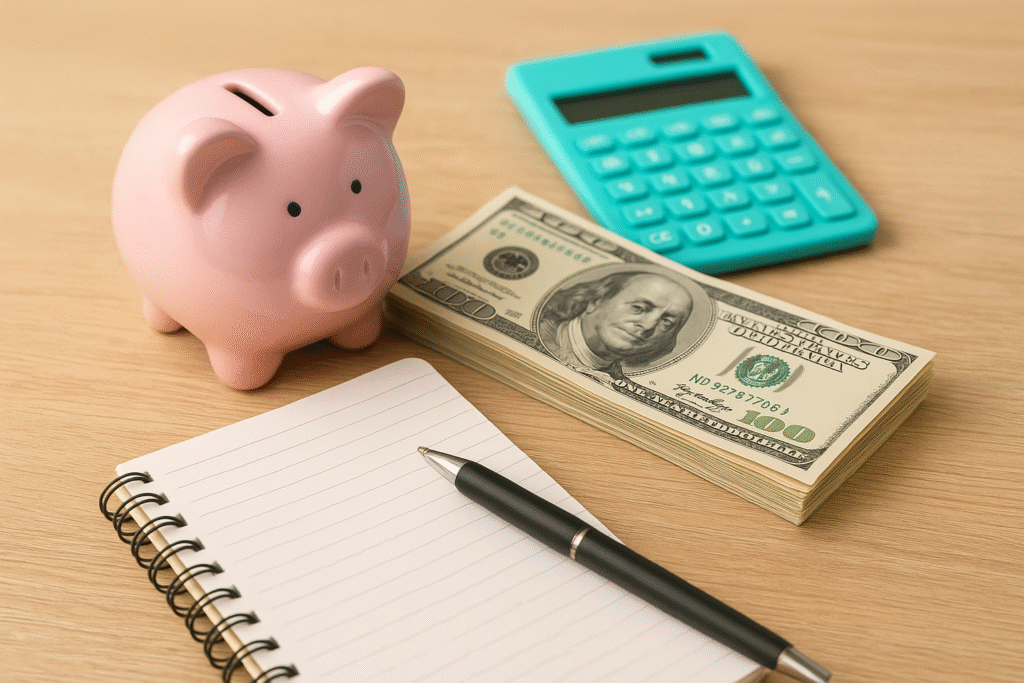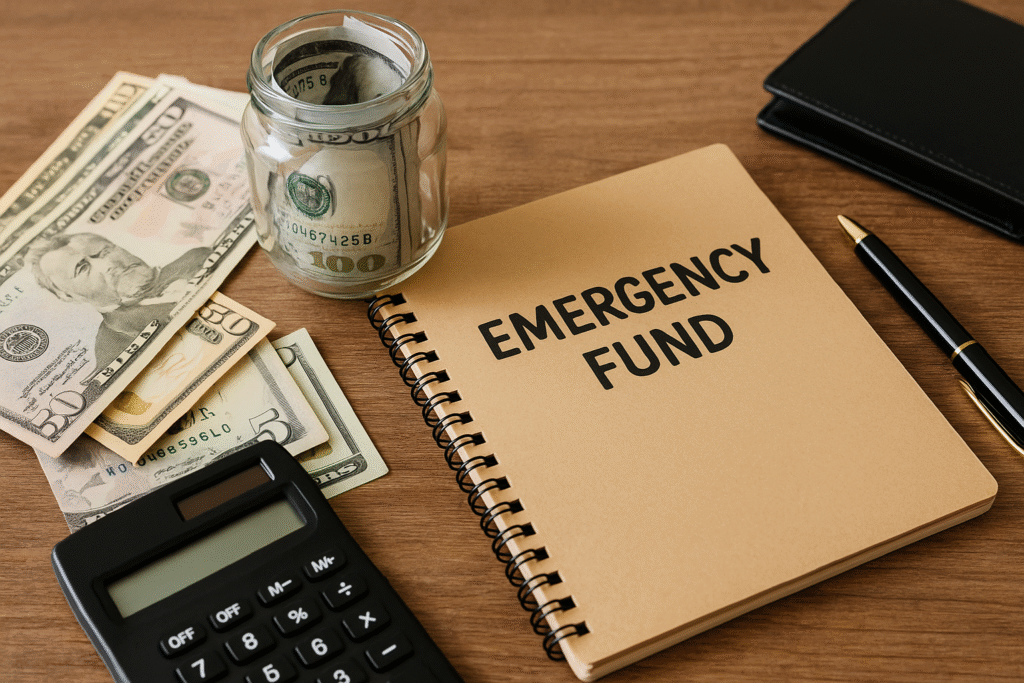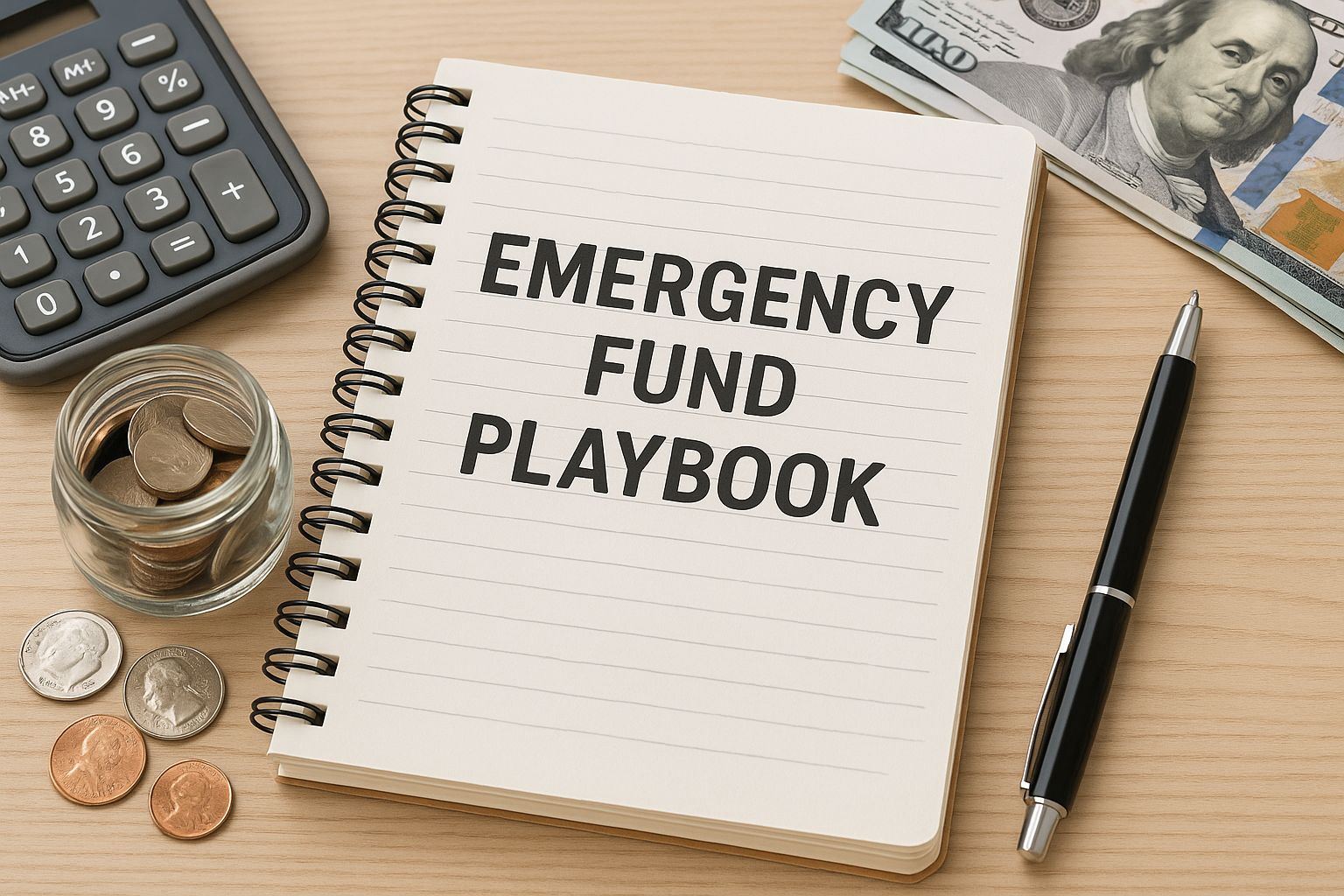Emergency Fund Playbook: Emergencies happen. The right emergency fund turns a crisis into a solvable problem — no predatory loans, no late bills, no panicked selling of investments. This playbook gives U.S. readers a clear, implementable plan (with numbers, examples, and government-verified resources) so you can build and use an emergency fund confidently in 2025.
All guidance below is grounded in official consumer-finance and Treasury resources and current through August 2025. Links to authoritative government pages are listed at the end of the article for cross-check and further detail.
Quick summary — what you’ll learn
- Exactly how much emergency fund to target (practical ranges).
- Where to keep your emergency cash (liquidity vs yield tradeoff).
- A cash-ladder example you can copy (3–12 month ladder).
- Alternatives (I-Bonds, T-bills) and when they make sense.
- A one-page printable checklist and rules for when to use the fund.
1) What an emergency fund is — definition in one line
An emergency fund is a deliberately liquid pool of money set aside to cover unexpected—but plausible—expenses or a sudden loss of income, such as job loss, emergency medical bills, urgent home or car repairs, or short-term income gaps. (Consumer Financial Protection Bureau)
2) How much emergency fund should you have? (realistic ranges)
There’s no single “correct” number — it depends on your personal situation. Use the ranges below as a practical starting point and then personalize:
- Minimal safety cushion (starter): $500–$1,000 — for routine small shocks if you have serious trouble saving. This is a short-term triage target. (Consumer Financial Protection Bureau)
- Basic emergency fund (entry level): 1–3 months of essential living expenses — for people with stable jobs, dual incomes, or easy access to short-term credit. (Consumer Financial Protection Bureau)
- Recommended (middle): 3–6 months of essential living expenses — the standard rule many advisors recommend for most households. This covers many common job losses and major repairs. (Consumer Financial Protection Bureau)
- Higher-security fund: 6–12 months (or more) — for self-employed people, freelancers, gig workers, households with a single wage earner, homeowners with large maintenance obligations, or if local unemployment durations are longer. (Consumer Financial Protection Bureau)
How to calculate “essential living expenses”: total the monthly amounts you must pay to keep your household running (rent/mortgage, minimum loan payments, utilities, insurance, groceries, essential transport, basic healthcare costs). Multiply by your target months (3, 6, etc.). Example: $3,500 monthly essentials → 6-month fund = $21,000.
3) Priorities: liquidity first, then yield
Emergency money must be available fast without market-loss risk. That means cash or cash-like, not stocks or long-term bonds you might be forced to sell at a loss. For most people the order of priorities is:
- Immediate liquidity (bank account transfers, debit access).
- Low principal risk (FDIC or NCUA insured deposits, short Treasury securities).
- Reasonable yield — choose options that give you some return while preserving liquidity and safety. (FDIC, NCUA)

4) Where to keep it — safe, liquid options (pros & cons)
A. High-yield savings account (online banks)
- Pros: instant transfers (same business day to next day), FDIC-insured, usually the easiest place to keep 1–3 months of cash.
- Cons: APYs change with market rates; online transfers to a checking account may take a day or two. Always confirm FDIC insurance for the bank. (FDIC)
B. Money Market Deposit Accounts (MMDAs) at banks / Money Market Accounts at credit unions
- Pros: often similar liquidity to savings, FDIC or NCUA insured, may offer check/write access depending on account.
- Cons: sometimes higher minimums or transaction limits. Confirm coverage with FDIC or NCUA. (FDIC, NCUA)
C. No-penalty or short-term CDs (1–6 months) & CD ladders
- Pros: slightly higher rates than savings if you ladder CDs; predictable return.
- Cons: early withdrawal penalties can reduce principal — for emergency funds, use no-penalty CDs or keep ladder rungs short (4–12 weeks) to maintain flexibility. Check terms carefully.
D. Treasury Bills (T-Bills) — short maturities (4–52 weeks)
- Pros: backstopped by the U.S. Treasury, very safe, short maturities let you ladder to liquidity and capture higher yields than some bank accounts. You can buy directly via TreasuryDirect or through a bank/broker. Minimums are low (often $100). (TreasuryDirect, TreasuryDirect)
- Cons: if you sell before maturity through a broker you may get a different price; TreasuryDirect redemptions occur at maturity (so ladder timing matters).
E. Series I Savings Bonds (I-Bonds)
- Pros: interest adjusts for inflation twice a year (protects purchasing power); backed by the U.S. government. Good for money you can leave untouched for at least 1 year. (TreasuryDirect)
- Cons: cannot redeem for 1 year; redeeming before 5 years costs the last 3 months’ interest — not ideal for immediate emergencies but excellent for part of a longer emergency fund (the “top” of your ladder) if you can tolerate that constraint. Purchase limits apply ($10,000 per person electronic I-Bond per calendar year, plus certain additional routes). (TreasuryDirect)
5) Cash ladder playbook — balance liquidity and yield (copyable plan)
A cash ladder spreads money across staggered maturities so you always have some rung maturing soon while earning higher yield on longer rungs.
Example: Build a 6-month emergency fund of $12,000 using a mixed ladder
- $4,000 → High-yield savings account (immediate access)
- $2,000 → 1-month no-penalty CD or Short T-Bill (matures monthly)
- $2,000 → 3-month CD or 13-week T-Bill
- $2,000 → 6-month CD or 26-week T-Bill
- $2,000 → I-Bond (only if you can leave it at least 1 year; otherwise keep in laddered T-bills)
How it works: if emergency hits, you use the savings + whichever ladder rungs have matured. As each rung matures, re-invest at the long end of the ladder to maintain the structure. This approach gives you the liquidity of savings plus a modest extra yield from CDs/T-bills and inflation protection from an I-Bond. TreasuryDirect and bank brokers sell T-bills; FDIC/NCUA insure bank/credit union accounts. (TreasuryDirect, TreasuryDirect, FDIC)
6) Alternatives & supplements — when to use them
- I-Bonds: good for a portion of funds you won’t need within 1 year but want inflation protection. Not a substitute for your immediate 1–3 months of liquidity. (TreasuryDirect)
- Short-term Treasury funds or T-Bills: useful for slightly higher yields while keeping durations short. Buy via TreasuryDirect or a brokerage. (TreasuryDirect)
- Cash back / emergency credit line: a small dedicated credit line or card with low or 0% APR (used only for emergencies) can supplement but not replace cash — credit costs interest if used. Use only as last resort.
- Insurance: a good health-insurance plan, homeowner’s / renter’s insurance, and disability income insurance reduce the size of the emergency fund you need for certain large shocks (medical bills, house damage, extended income loss).
7) When to use your emergency fund — clear rules (avoid “fun” withdrawals)
Use your emergency fund for:
- Loss of income (job loss, contract gap) after you’ve exhausted short-term measures.
- Unexpected essential repairs (roof, HVAC, car repairs) that you must fix to maintain income or safety.
- Emergency medical expenses not immediately covered by insurance.
- Short-term, unavoidable expenses that would otherwise force you into high-cost borrowing.
Don’t use it for:
- Non-essential splurges, routine vacations, or speculation.
- Regular bills that result from lifestyle choices (unless you’ve exhausted restructuring options). Treat those as budgeting issues, not emergencies.

8) Rebuilding the fund quickly — action plan after an emergency
- Triage: Pay immediate bills with the fund but keep records.
- Pause non-essentials until you’re back to target.
- Automate rebuilding: Set up a recurring transfer (e.g., weekly or monthly) from checking to your emergency fund account. Even $50–$200/month compounds over time. CFPB research shows small, automatic contributions greatly increase saving success. (Consumer Financial Protection Bureau)
- Consider one-time sources: tax refunds, stimulus payments, or part of windfalls (bonuses, gifts) can accelerate the rebuild.
9) Special cases — who needs more or less than 3–6 months
- Lower need (1–3 months): two-income household with employer-provided short-term disability, stable sector employment, and access to low-cost credit.
- Higher need (6–12+ months): self-employed/freelancers, seasonal workers, single-earner households, homeowners with older homes, or people living in an area with longer unemployment spells. Use local labor-market data and personal income volatility to guide the choice. CFPB data shows households with low emergency savings are much more vulnerable; adjust accordingly. (Consumer Financial Protection Bureau)
10) One-page checklist (print & pin to your fridge)
- Calculate essential monthly expenses.
- Pick your target months (1, 3, 6, 12) and compute target fund.
- Open one trusted high-yield savings account (FDIC-insured) for immediate liquidity.
- Build a short cash ladder (mix savings + short T-bills/CDs).
- Consider adding an I-Bond for funds you won’t touch for 1+ year.
- Automate a recurring transfer (payroll or bank transfer).
- Reassess annually or on major life changes (new job, child, house).
Final note — small habits beat big intentions
You don’t need to build a giant fund overnight. The best emergency funds are built steadily with automatic contributions, prioritized over nonessential spending. Even small, consistent savings reduce reliance on expensive credit and increase financial security. CFPB evidence shows that behavioral nudges and simple savings tools greatly improve real outcomes — start small, automate, and protect the core with insured, liquid vehicles. (Consumer Financial Protection Bureau)
Authoritative government resources (verified August 2025)
Use these official pages to confirm limits, open accounts, and compare products. All links below were active on my check in Aug 2025.
- CFPB — An essential guide to building an emergency fund (practical consumer steps & resources).
https://www.consumerfinance.gov/an-essential-guide-to-building-an-emergency-fund/ (Consumer Financial Protection Bureau) - CFPB — Evidence-based strategies to build emergency savings (report) (research on what works).
https://files.consumerfinance.gov/f/documents/cfpb_evidence-based-strategies-build-emergency-savings_report_2020-07.pdf (Consumer Financial Protection Bureau) - FDIC — Deposit insurance & “How much of my money is insured?” (brochures) — confirm FDIC insurance and coverage rules.
https://www.fdic.gov/resources/deposit-insurance/ and https://www.fdic.gov/resources/deposit-insurance/brochures/deposits-at-a-glance (FDIC) - NCUA — Share insurance coverage (credit unions) — for federally insured credit unions and coverage limits.
https://ncua.gov/consumers/share-insurance-coverage (NCUA) - TreasuryDirect — I-Bonds (Series I savings bonds) — inflation-adjusted savings bonds and rules (purchase limits, holding restrictions).
https://www.treasurydirect.gov/savings-bonds/i-bonds/ and https://www.treasurydirect.gov/savings-bonds/i-bonds/i-bonds-interest-rates/ (TreasuryDirect) - TreasuryDirect — Treasury Bills (T-Bills) & how to buy — short-term Treasury securities that are an excellent ladder component.
https://treasurydirect.gov/marketable-securities/treasury-bills/ and https://treasurydirect.gov/marketable-securities/buying-a-marketable-security/ (TreasuryDirect)
Disclaimer
This article is for informational purposes only and is not financial, legal, or investment advice. Rules, rates, and product features change; confirm current details with the official sources above (CFPB, FDIC, NCUA, TreasuryDirect) and consult a qualified financial professional for guidance tailored to your situation. All images used in this article are royalty‑free or licensed for commercial use and are provided here for illustrative purposes.
